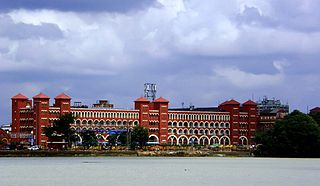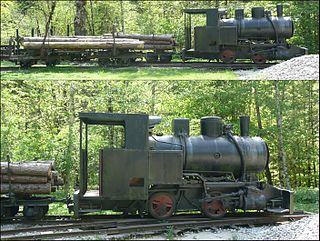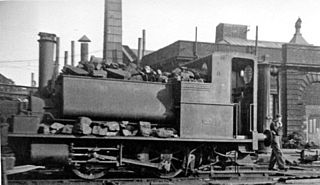
The Southern Railway (SR), sometimes shortened to 'Southern', was a British railway company established in the 1923 Grouping. It linked London with the Channel ports, South West England, South coast resorts and Kent. The railway was formed by the amalgamation of several smaller railway companies, the largest of which were the London & South Western Railway (LSWR), the London, Brighton and South Coast Railway (LB&SCR) and the South Eastern and Chatham Railway (SE&CR). The construction of what was to become the Southern Railway began in 1838 with the opening of the London and Southampton Railway, which was renamed the London & South Western Railway.

Brush Traction is a manufacturer and maintainer of railway locomotives, part of Wabtec Corporation, based at Loughborough in Leicestershire, UK, and situated alongside the Midland Main Line.
The footplate of a steam locomotive is a large metal plate that rests on top of the frames and is normally covered with wooden floorboards. It is usually the full width of the locomotive and extends from the front of the cab to the rear of cab or coal bunker just above the buffer beam. The boiler, the cab, and other superstructure elements are in turn mounted on the footplate. The footplate does extend beyond the front of the cab on some locomotives, but is then usually referred to as the "running board/plate." The footplate is where the Driver and Fireman stand in the cab to operate the locomotive, giving rise to the expression of working on the footplate for being in the cab of a steam locomotive. The part of the footplate ahead of the cab is referred to by a variety of different names.

Howrah Junction, more popularly known as Howrah Station, is the oldest and largest railway complex in India, serving the twin cities of Howrah and Kolkata. Approximately 617 passenger trains pass through the station each day requiring its 23 platforms and serving more than two million passengers per day with the highest train handling capacity of any Indian railway station. Howrah Junction is one of five intercity railway stations serving the city of Kolkata, the others being Sealdah, Santragachi, Shalimar, and Kolkata railway station. Howrah Junction is also one of the busiest stations in India as per passenger footfall. The station is located in Howrah on the west bank of the Hooghly River. 1373 stations across India are directly connected to Howrah Railway Station.

Green goddess is a salad dressing, typically containing mayonnaise, sour cream, chervil, chives, anchovy, tarragon, lemon juice, and pepper.

The New Zealand EO class of 1923 were electric locomotives used on the steep Otira to Arthurs Pass section of the Midland Line. They were primarily needed for pulling trains through the 1 in 33 grade 8.5 km (5.3 mi) Otira Tunnel which was too long and steep to allow steam locomotives to be used.

Tramways are lightly laid railways, sometimes worked without locomotives. Since individual tramway cars are not intended to carry the weight of typical standard-gauge railway equipment, the tramways over which they operate may be built of less substantial materials. Tramways can take many forms, sometimes just tracks temporarily laid on the ground to move materials around a factory, mine or quarry. Many, if not most, are narrow gauge railway technologies. Motive power can be manual, animal, cable hauled by stationary engine, or utilize small locomotives. At the other extreme they could be complex and lengthy systems, such as the Lee Moor Tramway in the county of Devon, England, in the United Kingdom.

The GER Class G15 was a class of ten 0-4-0T steam tram locomotives designed by Thomas William Worsdell for the Great Eastern Railway. They passed to the London and North Eastern Railway (LNER) at the 1923 grouping, and received the LNER classification Y6.

Thomas Green & Son, Ltd. were engineers who manufactured a wide range of products at the Smithfield Foundry, Leeds, United Kingdom

LNER Class Y11 was a class of petrol powered 0-4-0 locomotives built by Motor Rail & Tram Car Company Limited under their Simplex brand and introduced in the years 1919–1925, operating after its formation in 1922 on the London and North Eastern Railway (LNER). Their British Railways numbers were 15097-15099.

The GER Class 209 was a class of 0-4-0 saddle tank steam locomotives of the Great Eastern Railway. These locomotives were similar to the NBR G Class but had flat-topped, instead of round-topped, tanks. A total of eight were built – four by Neilson and Company in 1874 and four more by the GER's Stratford Works between 1897 and 1903.

A tram engine is a steam locomotive specially built, or modified, to work on a street, or roadside, tramway.
A1, A-1 or A.1. may refer to:
Amazon usually refers to:

The GER Class E72 was a class of ten 0-6-0 steam locomotives designed by S. D. Holden for the Great Eastern Railway. They all passed to the London and North Eastern Railway at the 1923 grouping and received the classification J18.

The G&SWR 5 Class were 0-6-0T steam locomotives designed by Peter Drummond for the Glasgow and South Western Railway (G&SWR) and introduced in 1917. The class was originally designated 5 Class but, after the G&SWR's 1919 renumbering, this was changed to 322 Class. After passing to the London, Midland and Scottish Railway (LMS) in 1923 they were given power classification 2F.















